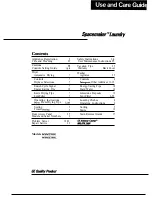
EN
EN
54
55
• Manual pressure valves
must be set to the “Open” or “Closed” position manu-
ally. For ventilating the container, manually
set the pressure valve to “Open”.
• Some containers offer a pressure indicator for controlling the pressure within the
container.
IMPORTANT TIPS FOR VACUUM SEALING
IMPORTANT -
Vacuum sealing is NO substitute for refrigeration or freezing. Any
perishable food that requires refrigeration must still be refrigerated or frozen after
vacuumizing. As with any other storage method, food must be checked carefully
before storage and, as well, before consumption.
Vacuumizing extends the shelf life of food by removing most of the air from sealed
bags and containers, and additionally preventing air and germs from getting into the
sealed packaging again. Additionally, vacuumizing helps inhibiting the growth of
a lot of microorganisms. However, please keep in mind that mould and some types
of bacteria (e.g. the highly toxic botulism causing bacterium) can grow even without
air. Some produce spores still viable after evacuation. In general, bags may be re-
used, but do not re-use bags that had been filled with any fatty and/or highly peris-
hable types of food (e.g. meat, sausages, cheese, fish, or seafood). Some types of
food contain aromas and colours that infuse plastics and cause persistent odours and
discolouration (e.g. red cabbage, capsicum, onion, garlic, some types of cheese
or sausages). Before re-utilisation of bags and containers, you should check whether
any odours of the recently stored food persist within the bags or containers.
• Before vacuumizing, some types of food (e.g. vegetables) need to be blanched
or cooked until they are completely done. This stops enzyme reactions causing
loss in quality.
• Some vegetables (broccoli, sprouts, cabbage, cauliflower, kale, turnips) natu-
rally emit gases during storage. Therefore, even after blanching, they are not
suited for vacuum packaging.
• Vacuum containers are perfectly suited for marinating food in a short time,
because the micro-pores of the food are opened under low pressure.
IMPORTANT -
Make a short break of approx. 20 seconds after each cycle of
operation. Following this advice is quite simple, when using this time for preparing
the next bag or container.
When the overheat protection has been triggered, unplug the appliance and wait
for approx. 30 minutes, leaving the lid open. Thereafter, you can re-assume opera-
tion as normal.
VACUUM CONTAINERS
WARNING
– Only use pressure-proof containers. Ensure that the container
and container lid are in proper condition, before connecting the container to the
appliance. Evacuated containers must be handled with special care.
Always ven-
tilate evacuated containers, before attempting to open the lid.
Do not let child-
ren play with the containers—especially when they are evacuated!
IMPORTANT -
To prevent germs from getting into your food, you should sterilize
the containers, before filling in food. For this, you may rinse most types of con-
tainers using hot water (at least 80°C). However, ensure that the container will
tolerate the high temperature. If in doubt, get in contact with the manufacturer.
After sterilization, do not wipe the container but leave it dry naturally on a clean
surface. When wiping with a cloth, germs could get onto the surfaces of the con-
tainer again.
NOTE
The vacuum hose of the appliance may not fit to the pressure valve of containers
not recommended by the manufacturer. Before operation, check whether your
container is suited for usage with the appliance. You may order appropriate con-
tainers via your vendor.
Before placing evacuated containers into the freezer, check whether your containers
are suited for freezing (e.g. check for appropriate icons), because some types of
plastic get brittle under freezing temperature conditions. Especially when taking the
container out of the freezer, these containers could burst causing risk of injuries and
damage according to splinters and splashes being hurled about. Always remove the
lid of the container completely, before warming up any food within it. Do not heat
the container via sources of high heat (e.g. oven, range, fire). It is best to use a bain-
marie. Microwave-safe containers may be warmed up within a microwave oven.
• Types of Vacuum Containers Some containers are operated via a
check valve
that will be opened and closed automatically. For ventilating the container
the
additional ventilation feature must be agitated manually.












































